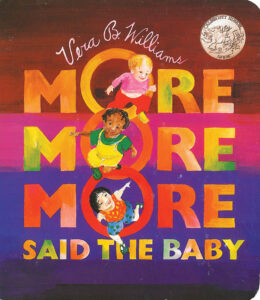Receptive language, Expressive language
A young infant participates in a book sharing focused on pictures of young children and their family members.



[Sit with the young infant reclined in your lap. Support the infant’s head in the bend of your arm so you can use your hands to hold the book and turn the pages while also securely holding the infant.
Hold the book about 12 inches from the infant and point to the picture on the cover.]
 Here are pictures of babies. The babies are smiling. They are moving their bodies. I think the babies are having fun!
Here are pictures of babies. The babies are smiling. They are moving their bodies. I think the babies are having fun!
Our book tells us what some babies do with people in their families.
[Use the following strategies to engage the infant in the book:
[Describe what happened. Example: “The babies in our book said ‘more, more, more!’ You cooed when we looked at the picture of the baby hugging his grandma. Thank you for sharing this book with me!”]
Receptive language, Expressive language
An infant participates in a book sharing with opportunities to help turn pages and communicate about young children doing things with their families.



 Invite an infant to sit next to you or on your lap to read a book. Introduce the book by pointing to the cover and encouraging the infant to look at the picture with you. Example: “Look at the babies! The babies are smiling! Our book tells us about babies doing fun things with their families.” Use the following strategies to engage the infant in the book:
Invite an infant to sit next to you or on your lap to read a book. Introduce the book by pointing to the cover and encouraging the infant to look at the picture with you. Example: “Look at the babies! The babies are smiling! Our book tells us about babies doing fun things with their families.” Use the following strategies to engage the infant in the book:
Receptive language, Expressive language
An older infant participates in a book sharing with opportunities to help manage the book and communicate about babies doing things with their families.



 Invite an older infant to read a book with you. The infant may wish to sit next to you or stand close while you read. Introduce the book and invite the infant to help you hold the book and turn the pages. A standing infant may want to use one hand to help turn the pages.
Invite an older infant to read a book with you. The infant may wish to sit next to you or stand close while you read. Introduce the book and invite the infant to help you hold the book and turn the pages. A standing infant may want to use one hand to help turn the pages.
Once the infant is comfortable, point to and describe the picture on the book cover. Example: “Look at the babies. The babies are smiling and having fun! Our book is about babies doing things with people in their families.” Use the following strategies to engage the infant in the book:
Many infants will connect with this book’s familiar theme of playing with a loved one. Infants will likely enjoy looking at the rich colors of the illustrations. Some of the pictures may be challenging to decipher without your guidance. Help infants to understand what is happening in the pictures by describing the actions of the babies and their family members. Infants will show interest in the pictures by gazing, pointing, touching, or using their hands to bat at or tap the pictures. Infants may also express interest in the book by cooing, babbling, and/or saying a word or part of a word.
The book is longer than what some infants can be expected to pursue. Focus on one or two of the book’s three sections. Each section has a tidy storyline. You can return to another section at a later time if an infant remains interested in the book.
Extra support
Enrichment
Materials Needed: “More More More,” Said the Baby by Vera B. Williams
Be Prepared: Learn the American Sign Language sign for “more.”
Young infants may enjoy learning the ASL sign for the word more. Sign “more” each time you say the word while reading the book. This sign can be used throughout the day, such as when you ask an infant if he/she would like more of something. Many infants will quickly learn and use this simple sign. Consistently acknowledge an infant’s use of the “more” sign. Example: “I see your hands. You are saying ‘more!’ You are telling me you want ‘more’ milk!”
Materials Needed: “More More More,” Said the Baby by Vera B. Williams
This book will be of interest to older children in your setting. Encourage older children to recite some of the book’s repetitive phrases with you. Some older infants may imitate a version of the words “more, more, more!” Talk with children about specific parts of the colorful illustrations. Invite children to tell about things they like to do again and again (more, more, more) with their loved ones.